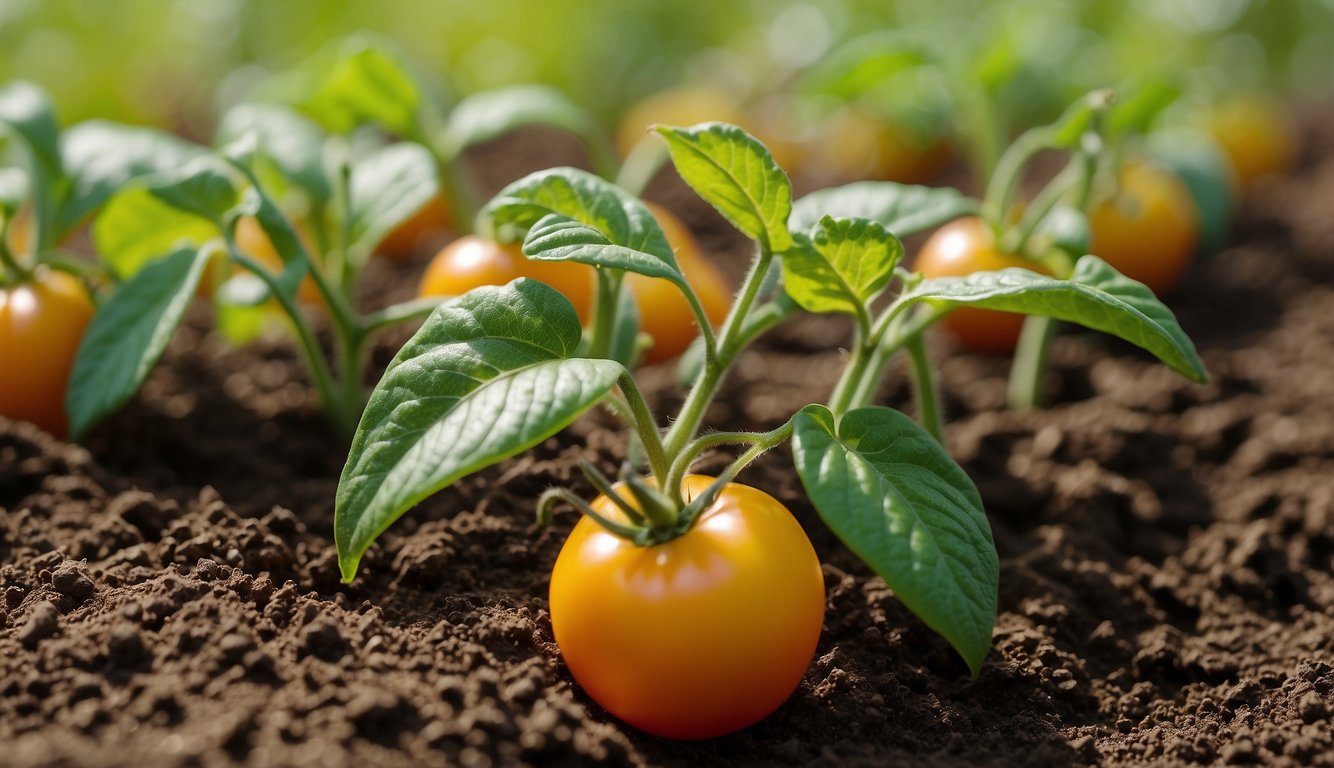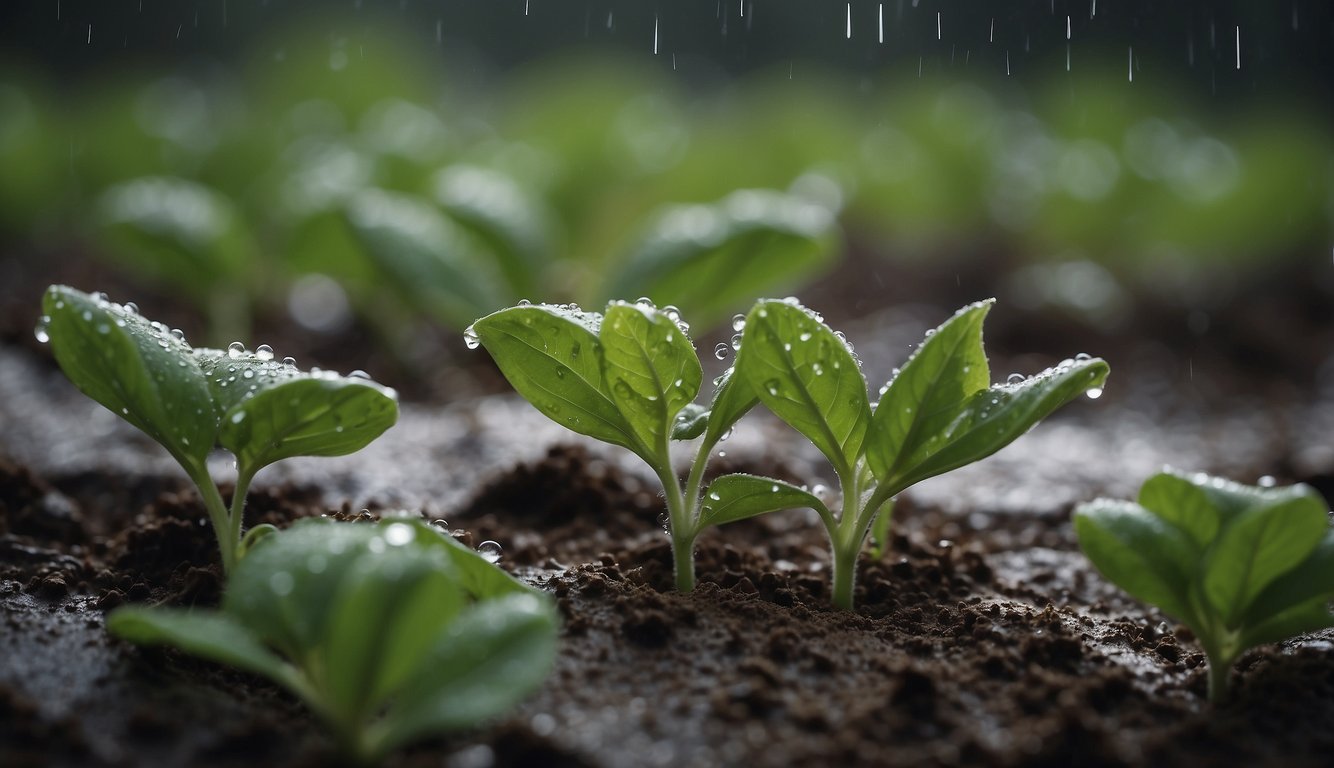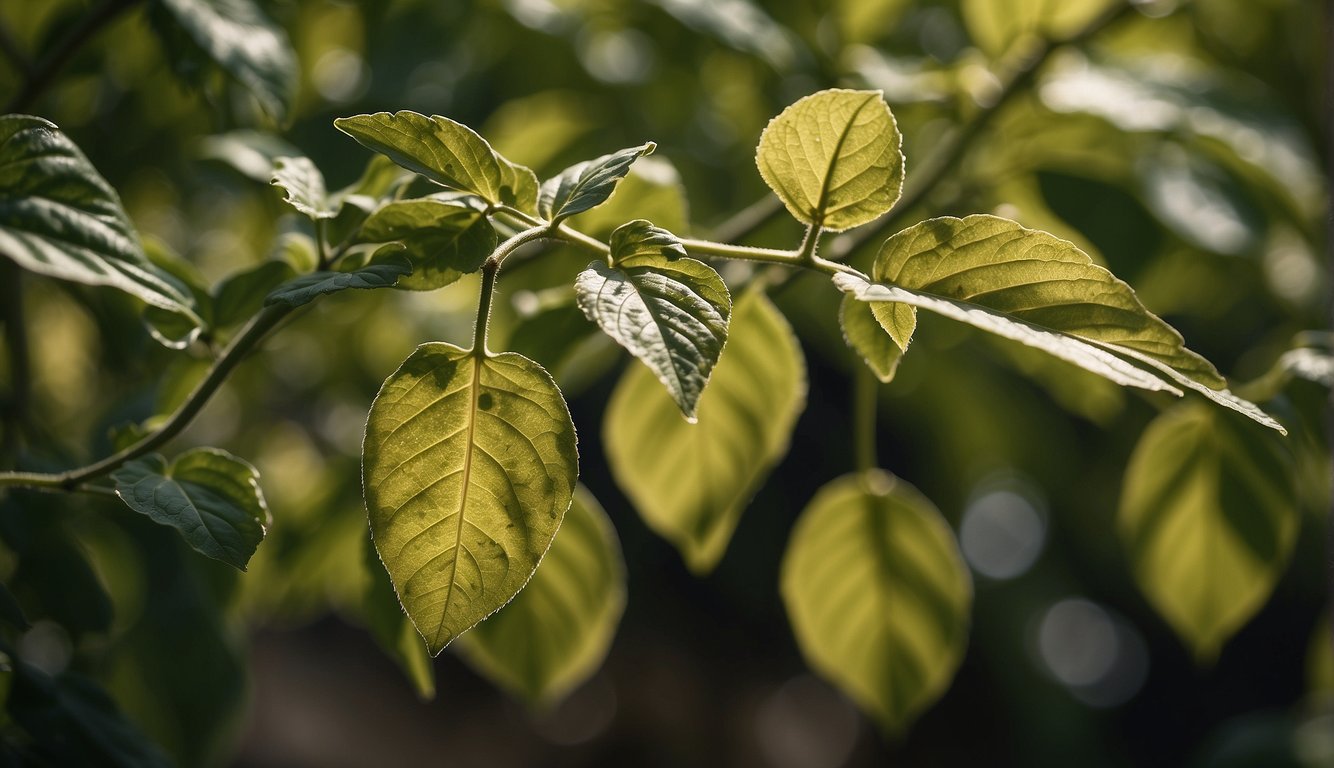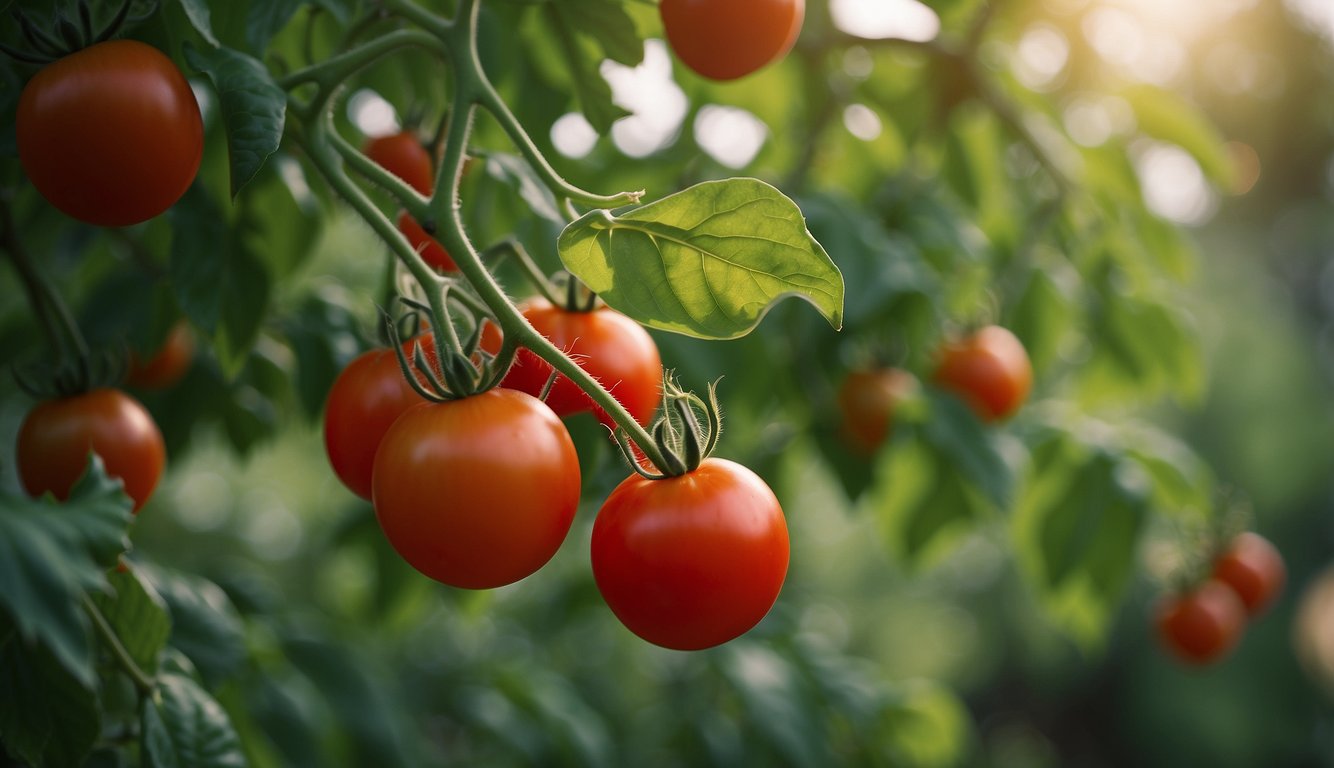Pale tomato leaves can signal a nutrient deficiency in the plant. As a gardener, it’s crucial to understand what causes this condition and how to address it. This ensures your tomato plants grow and produce healthy fruit.
There are several reasons why tomato leaves may turn pale. One of the most common causes is a lack of nutrients, particularly nitrogen, which is essential for healthy plant growth. Other nutrient deficiencies, such as potassium, calcium, and zinc, can also cause pale leaves. Additionally, overwatering or underwatering your plants can lead to nutrient imbalances and pale leaves.
If you notice your tomato leaves turning pale, it’s important to take action to address the underlying cause. This may involve adjusting your watering schedule, fertilizing your plants with a balanced fertilizer, or adding specific nutrients to the soil. By understanding the causes of pale tomato leaves and taking steps to address them, you can help ensure your tomato plants thrive and produce an abundant harvest.
Understanding Pale Tomato Leaves
As a tomato plant owner, it is essential to know the significance of leaf color. Pale leaves are a common problem among tomato plants, and they can indicate a variety of issues. In this section, I will explain the significance of leaf color and the common causes of pale leaves.
Significance of Leaf Color
The color of tomato plant leaves is significant because it indicates the plant’s health status. Green leaves are healthy and full of chlorophyll, which is responsible for photosynthesis. Photosynthesis is the process by which plants convert sunlight into energy. When leaves turn pale, it means that the plant is not producing enough chlorophyll, and photosynthesis is not happening correctly.
Common Causes of Pale Leaves
There are several common causes of pale tomato leaves. One of the most common causes is a nutrient deficiency, such as a lack of nitrogen. Nitrogen is essential for plant growth and is responsible for producing chlorophyll. If the plant is not getting enough nitrogen, the leaves will turn pale.
Another common cause of pale leaves is pests. Certain pests can damage the foliage of the tomato plant, causing the leaves to turn yellow and eventually pale. Spider mites and whiteflies are two common pests that can cause this problem. If you suspect that pests are causing the problem, it is essential to take action quickly to prevent further damage.
Lastly, environmental factors can also cause pale leaves. If the tomato plant is not getting enough sunlight or water, the leaves may turn pale. Overwatering can also cause the roots to rot, which can lead to pale leaves. It is essential to ensure that the tomato plant is getting the right amount of sunlight, water, and nutrients to prevent pale leaves.
Pale leaves are a common problem among tomato plants, and they can indicate a variety of issues. It is essential to understand the significance of leaf color and the common causes of pale leaves to keep your tomato plants healthy and thriving.
Soil and Nutrient Management

As a tomato plant grows, it requires a steady supply of essential nutrients to develop healthy foliage and produce high-quality fruit. In this section, I will cover the basics of soil and nutrient management for tomato plants.
Soil pH and Nutrient Availability
The pH level of soil plays a critical role in nutrient availability. Tomato plants prefer slightly acidic soil with a pH between 6.0 and 6.8. When the soil pH is too high or too low, some essential nutrients become less available to the plant. For example, calcium is less available in acidic soils, which can lead to blossom end rot. On the other hand, iron is less available in alkaline soils, which can cause iron deficiency.
Essential Nutrients for Tomato Plants
Tomato plants require a variety of essential nutrients to grow healthy foliage and produce high-quality fruit. The three primary macronutrients are nitrogen, phosphorus, and potassium. Nitrogen is essential for vegetative growth, phosphorus for root development and fruiting, and potassium for overall plant health and disease resistance. In addition to these macronutrients, tomato plants require several micronutrients, including calcium, magnesium, and zinc.
Identifying Nutrient Deficiencies
Nutrient deficiencies can cause a wide range of symptoms in tomato plants, including pale leaves, stunted growth, and poor fruit quality. It’s essential to identify nutrient deficiencies early so that corrective measures can be taken. Some common nutrient deficiencies in tomato plants include nitrogen deficiency, magnesium deficiency, and potassium deficiency.
To address nutrient deficiencies, it’s important to maintain proper soil pH, use high-quality fertilizers, and incorporate organic matter and manure into the soil. Regular soil testing can also help identify nutrient deficiencies and guide fertilizer application. By implementing proper soil and nutrient management practices, you can help ensure healthy tomato plants and a bountiful harvest.
Watering Practices
As a tomato plant owner, I know that proper watering practices are essential to keep my plants healthy. In this section, I will discuss some of the best watering techniques for tomato plants and the effects of both overwatering and underwatering.

Proper Watering Techniques
One of the most important things to keep in mind when watering tomato plants is to water them deeply but infrequently. This means that you should water the plant until the soil is moist to a depth of 6-8 inches. However, you should not water the plant again until the top inch of soil is dry to the touch. Overwatering can lead to root rot and other fungal diseases, which can cause the leaves to turn yellow and wilt.
Another important aspect of proper watering is to avoid getting the leaves wet. Watering the leaves can promote the growth of fungal diseases, which can cause the leaves to turn pale and yellow. Instead, water the soil around the base of the plant, using a drip irrigation system or a watering can with a spout that can be directed at the soil.
Effects of Overwatering and Underwatering
Overwatering can be just as harmful to tomato plants as underwatering. When a plant is overwatered, the roots are deprived of oxygen, which can cause them to rot and die. This can lead to stunted growth, yellowing leaves, and wilting. In severe cases, the plant may die.
Underwatering can also have negative effects on tomato plants. When a plant is underwatered, it cannot absorb enough water to support its growth and development. This can cause the leaves to turn pale and yellow, and the plant may wilt. In severe cases, the plant may die.
Proper watering practices are essential for the health of tomato plants. By watering the plant deeply but infrequently and avoiding getting the leaves wet, you can help prevent fungal diseases and promote healthy growth. Additionally, it is important to avoid both overwatering and underwatering, as both can have negative effects on the plant.
Disease and Pest Management

As a tomato plant owner, it is essential to know how to manage common tomato plant diseases and pest infestations. Here are some tips to help keep your tomato plants healthy and thriving.
Common Tomato Plant Diseases – Pale Tomato Leaves
Tomato plants are susceptible to various diseases caused by fungi, viruses, and bacteria. Some of the most common tomato plant diseases include Verticillium wilt, Fusarium wilt, Early blight, Septoria leaf spot, and Late blight.
Verticillium wilt and Fusarium wilt are caused by soil-borne fungi that infect tomato plants through their roots. The symptoms of these diseases include yellowing and wilting of the lower leaves, followed by wilting of the entire plant. Unfortunately, there is no cure for these diseases, and infected plants should be removed and destroyed to prevent the spread of the fungus.
Early blight and Septoria leaf spot are fungal diseases that affect the leaves of tomato plants. Early blight causes yellowing and brown spots on the lower leaves, while Septoria leaf spot causes small, dark spots on the leaves. These diseases can be managed by removing infected leaves and applying a fungicide.
Late blight is a serious fungal disease that affects the leaves, stems, and fruit of tomato plants. The symptoms of late blight include dark spots on the leaves, stems, and fruit, followed by rapid wilting and decay of the plant. Infected plants should be removed and destroyed immediately to prevent the spread of the disease.
Pest Infestations and Control
Tomato plants are also susceptible to pest infestations, including aphids, whiteflies, spider mites, flea beetles, and nematodes. These pests can cause significant damage to the leaves, stems, and fruit of tomato plants.
Aphids and whiteflies are tiny insects that feed on the sap of tomato plants, causing yellowing and curling of the leaves. Spider mites are another common pest that feeds on the leaves of tomato plants, causing yellowing and webbing. Flea beetles are small, jumping insects that feed on the leaves of tomato plants, causing small holes and wilting.
Nematodes are microscopic worms that live in the soil and feed on the roots of tomato plants. Infected plants will show stunted growth, yellowing, and wilting.
To control pest infestations, it is essential to monitor your tomato plants regularly and take action at the first sign of an infestation. You can use natural remedies such as neem oil or insecticidal soap to control pests, or you can use chemical pesticides if the infestation is severe. It is essential to follow the instructions on the pesticide label carefully to avoid damaging your tomato plants or harming beneficial insects.
Environmental Factors – Pale Tomato Leaves

As a gardener, I have come across tomato plants with pale leaves on several occasions. One of the possible reasons for this is environmental factors. Here are some factors that can contribute to pale tomato leaves:
Sunlight and Tomato Plant Health – Pale Tomato Leaves
Sunlight is an essential factor for the growth and development of tomato plants. If the plants are not getting enough sunlight, they may become pale. Direct sunlight is necessary for the production of chlorophyll, which gives the leaves their green color. Without enough chlorophyll, the leaves may become pale.
On the other hand, too much sunlight can also damage the leaves. Sunscald and sunburn are common problems that occur when tomato plants are exposed to direct sunlight for an extended period. Sunscald appears as white patches on the fruit, while sunburn causes the leaves to turn white or brown and eventually die.
Temperature and Weather Conditions
Cold temperatures can also cause tomato leaves to turn pale. When the temperature drops below 50°F, the plants may become stressed, and the leaves may lose their green color. Lack of sunlight combined with cold temperatures can worsen the situation.
In addition to cold temperatures, extreme weather conditions such as heavy rain, strong winds, and hail can also damage the leaves and make them pale. It is essential to protect the plants from harsh weather conditions by providing them with proper support and shelter.
Environmental factors such as lack of sunlight, direct sunlight, cold temperatures, and extreme weather conditions can contribute to pale tomato leaves. As a gardener, it is crucial to monitor these factors and provide the plants with the necessary care and protection.
Cultivation and Care – Pale Tomato Leaves

As a tomato plant grows, it is important to take care of it properly to ensure it remains healthy and produces a bountiful harvest. Here are some tips on how to do just that.
Selecting the Right Tomato Varieties
When selecting tomato varieties, it is important to choose ones that are suited to your climate and growing conditions. For example, if you live in a hot and humid area, you may want to choose a variety that is resistant to diseases such as fusarium and verticillium wilt. You may also want to consider the size of the plant and the fruit it produces, as well as the flavor and texture of the tomatoes.
Transplanting and Repotting Best Practices
When it comes to transplanting and repotting tomato seedlings, it is important to handle them with care. Make sure to water the seedlings well before transplanting them, and be gentle when removing them from their original container. When repotting, choose a container that is slightly larger than the previous one, and make sure to add fresh soil and organic fertilizer to the new container.
Pruning and Maintenance
Pruning tomato plants can help to increase airflow and sunlight exposure, which can lead to healthier plants and larger fruit. To prune, remove any suckers that grow between the main stem and the leaves, as well as any yellow or diseased leaves. It is also important to fertilize tomato plants regularly, using organic fertilizers such as gypsum and epsom salts, and to mulch around the base of the plant to help retain moisture and prevent weeds.
By following these tips for cultivation and care, you can help your tomato plants thrive and produce a bountiful harvest of delicious, healthy tomatoes.
Troubleshooting Common Problems – Pale Tomato Leaves

As a tomato gardener, it is essential to identify and troubleshoot common problems with your plants. Here are some of the common problems you might encounter when growing tomatoes.
Yellow Leaves and Deficiencies – Pale Tomato Leaves
Yellow leaves on tomato plants are a common problem that can be caused by nutrient deficiencies or pests. Nitrogen deficiency is one of the most common causes of yellow leaves. In this case, the lower leaves turn yellow first, and the yellowing progresses up the plant. To fix this problem, add nitrogen-rich fertilizer to the soil.
Calcium deficiency is another common cause of yellow leaves in tomato plants. This deficiency can cause blossom end rot, which is a condition that causes the bottom of the tomato to turn brown and mushy. To fix this problem, add calcium-rich fertilizer to the soil.
Physical Damage and Growth Issues
Physical damage and growth issues can also cause problems with tomato plants. Catfacing is a condition that causes the fruit to have scars and deformities. This condition is caused by cold temperatures during pollination. To prevent catfacing, cover the plants during cold weather.
Wilt is another common problem that can be caused by physical damage or growth issues. This condition causes the leaves to wilt and the plant to look sickly. To fix this problem, water the plant regularly and make sure it has adequate drainage.
Identifying and troubleshooting common problems with tomato plants is essential for a successful harvest. Whether it’s yellow leaves, brown spots, or blossom end rot, understanding the problem and taking the necessary steps to fix it will help ensure a bountiful harvest.
Enhancing Tomato Plant Health – Pale Tomato Leaves

As a gardener, I always strive to maintain healthy tomato plants to ensure maximum fruit production. Pale leaves are an indication of a nutrient deficiency, which can be corrected with proper fertilization and feeding schedules, building a healthy soil ecosystem, and preventive measures and regular monitoring.
Fertilization and Feeding Schedules
Tomato plants require a balanced fertilizer that contains essential nutrients such as nitrogen, phosphorus, and potassium. A tomato feed with a balanced NPK ratio of 5-10-10 or 10-10-10 is ideal for healthy plant growth and fruit production. I recommend feeding tomato plants with liquid fertilizer every two weeks during the growing season. Liquid fertilizer is quickly absorbed by the roots and provides an immediate boost to the plant’s health.
Building a Healthy Soil Ecosystem – Pale Tomato Leaves
A healthy soil ecosystem is crucial for tomato plant health. I recommend adding aged manures or compost to the soil to improve its structure and fertility. Compost piles are also a great way to provide organic matter to the soil. Beneficial fungi and bacteria (BFB) are essential for healthy plant growth and can be added to the soil through compost or aged manures.
Preventive Measures and Regular Monitoring
Preventive measures and regular monitoring can help to avoid tomato plant problems. I recommend planting tomato plants in a greenhouse where they can be protected from environmental stressors such as extreme temperatures and fungal diseases. Pesticides should be used sparingly, and air circulation should be adequate to prevent fungal diseases.
Maintaining healthy tomato plants requires a combination of proper fertilization and feeding schedules, building a healthy soil ecosystem, and preventive measures and regular monitoring. By following these steps, gardeners can ensure healthy plant growth and maximum fruit production.
Pale Tomato Leaves
Let’s delve into the world of pale tomato leaves and their causes.
Firstly, we have nutrient deficiency. If your tomato leaves are turning pale, they might be crying out for more nutrients!
Next, let’s talk about watering. Too much or too little can stress your plants, leading to pale leaves. Balance is key!
Ever heard of disease? Diseases like blight or wilt can cause your tomato leaves to pale. Keep an eye out for other symptoms!
And let’s not forget sunlight. Tomatoes love the sun, but too much can cause leaf scorch, leading to pale leaves.
Remember, folks, gardening is all about balance. So, let’s keep planting, keep nurturing, and keep enjoying the fruits (and veggies) of our labor!
For more gardening wisdom, don’t forget to visit my homepage at theherbprof.com. Keep those green thumbs up!
References – Pale Tomato Leaves
Little Herb Encyclopedia, by Jack Ritchason; N.D., Woodland Publishing Incorporated, 1995
The Ultimate Healing System, Course Manual, Copyright 1985, Don Lepore
Planetary Herbology, Michael Tierra, C.A., N.D., Lotus Press, 1988
Handbook of Medicinal Herbs, by James A. Duke, Pub. CRP Second Edition 2007
The Complete Medicinal Herbal, by Penelope Ody, Published by Dorling Kindersley
Check the Following Articles!
How to Get Rid of Rhubarb: A Comprehensive Guide
Hoya Plant Bloom: Triggering and Maintaining Blossoms
How to Get Orchids to Rebloom: Tips and Tricks
How to Grow Moss Inside: Get A Lush Indoor Garden
Frequently Asked Questions – Pale Tomato Leaves

How can nitrogen deficiency be addressed in tomato plants?
Nitrogen deficiency in tomato plants can be addressed by using fertilizers that are high in nitrogen content. A balanced fertilizer, with equal amounts of nitrogen, phosphorus, and potassium, can also be used. Organic fertilizers, such as compost and manure, can also help to increase nitrogen levels in the soil. It’s important to avoid over-fertilizing, as this can lead to other issues like blossom-end rot.
What treatments are effective for yellowing tomato leaves?
Yellowing tomato leaves can be treated by first identifying the cause. If the cause is a nutrient deficiency, then fertilizers can be applied to the soil. If the cause is a disease, then fungicides may be necessary. In some cases, simply removing the affected leaves can help to prevent the spread of the disease. It’s important to properly dispose of any infected plant material to prevent the disease from spreading.
Why is the bottom foliage of my tomato plant turning yellow?
Yellowing of the bottom foliage of tomato plants can be caused by a number of factors, including nutrient deficiencies, overwatering, and disease. If the yellowing is accompanied by wilting or drooping, then overwatering may be the issue. If the yellowing is accompanied by brown spots or lesions, then disease may be the issue.
What causes tomato plant leaves to turn yellow and curl?
Tomato plant leaves can turn yellow and curl due to a variety of reasons, including disease, pests, and environmental factors. Tomato mosaic virus, a fungal disease, is a common cause of yellowing and curling of tomato leaves. Aphids and spider mites can also cause yellowing and curling of leaves. Environmental factors, such as extreme temperatures or drought, can also cause yellowing and curling of leaves.
How do you remedy yellow and brown discoloration on tomato leaves?
Yellow and brown discoloration on tomato leaves can be remedied by first identifying the cause. If the cause is a nutrient deficiency, then fertilizers can be applied to the soil. If the cause is a disease, then fungicides may be necessary. In some cases, simply removing the affected leaves can help to prevent the spread of the disease.
Can overwatering lead to yellow leaves on tomato plants, and how can it be corrected?
Yes, overwatering can lead to yellow leaves on tomato plants. When plants are overwatered, the roots become waterlogged and cannot absorb nutrients properly. This can lead to nutrient deficiencies, which can cause yellowing of the leaves. To correct overwatering, it’s important to reduce watering frequency and ensure that the soil has proper drainage.

